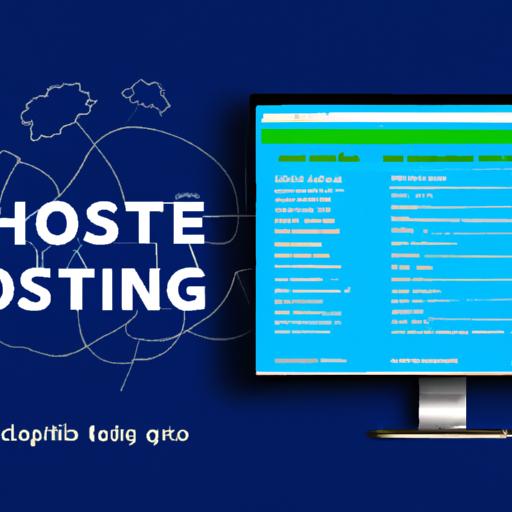Docker Run Network Host: Unleashing the Power of Container Networking
Introduction
Have you ever wondered how modern applications are built and deployed? In the world of software development, Docker has revolutionized the way we package, distribute, and run applications. With its exceptional containerization capabilities, Docker has become an essential tool for developers and system administrators alike. But what about networking within these containers?
In this article, we will delve into the world of Docker networking and explore the intricacies of the docker run command with a specific focus on the network and host options. By the end, you will have a firm grasp on how to effectively utilize these features to enhance the networking capabilities of your Docker containers.
Understanding Docker Run Command
Before we dive deeper, let’s take a moment to understand the docker run command. It is the fundamental command that allows us to create and run Docker containers. With its various options and flags, we can customize the behavior and configuration of our containers.
Overview of Docker Networking
Docker networking is a vital aspect of containerization. It enables seamless communication between containers and the host system, as well as facilitates inter-container communication. By default, Docker creates a bridge network, which acts as a private network for containers. However, this default network has its limitations, and that’s where the network and host options come into play.
Stay tuned as we explore the power of these options in the upcoming sections. We will uncover how they can revolutionize the way your containers interact with the network, providing greater flexibility, security, and efficiency.
So, let’s embark on this networking adventure together and unlock the full potential of Docker’s docker run command. Buckle up, and let’s dive in!
Understanding Docker Run Command
Docker, with its powerful containerization technology, has gained immense popularity in the software development community. At the heart of Docker’s functionality lies the docker run command, which plays a crucial role in creating and running Docker containers.
Explanation of the “docker run” command and its functionalities
The docker run command serves as a gateway to the world of Docker containers. It allows you to specify various parameters, configurations, and options to tailor the behavior of your containers. With this command, you can define the image you want to run, set environment variables, map ports, and much more.
Introducing the different options and flags available
Within the docker run command, there are numerous options and flags that offer extensive customization capabilities. These options allow you to control the networking, storage, security, and resource allocation aspects of your containers.
One of the essential flags is the network flag, which enables you to connect your container to a specific network. By leveraging this flag, you can control how your container communicates with other containers and the outside world.
Highlighting the significance of the “network” flag for networking purposes
The network flag in the docker run command is a game-changer when it comes to Docker networking. It allows you to explicitly define the network that your container should be a part of, enabling seamless communication with other containers on the same network.
By leveraging the network flag, you can achieve network isolation, better security, and enhanced performance for your containers. It provides a structured and controlled environment for your containers to interact, ensuring smooth operation within complex application architectures.
In the upcoming sections, we will explore the network flag in more detail and dive into other networking options available with Docker. So, let’s continue our journey and unlock the true potential of Docker networking with the docker run command.
Introduction to Docker Networking
Docker networking is the backbone that enables seamless communication between containers and the external world. Understanding the basics of Docker networking is crucial for harnessing the full potential of containerization. So, let’s dive into the world of Docker networking and explore its key aspects.
Brief Overview of Docker Networking
At its core, Docker networking allows containers to communicate with each other and the host system. By default, Docker creates a bridge network for containers, which acts as a private network isolated from the host and other networks. This bridge network enables containers to communicate with each other using IP addresses. However, the default bridge network has its limitations.
Explanation of the Default Bridge Network and Its Limitations
The default bridge network in Docker provides connectivity among containers running on the same host. It assigns IP addresses to containers and performs NAT (Network Address Translation) to enable outbound connectivity. However, containers on different hosts or external systems cannot directly communicate with containers in the default bridge network.
This limitation poses challenges for scenarios such as multi-host communication or accessing services running outside the container environment. To overcome these limitations, Docker provides various networking options.
Introduction to Other Types of Docker Networks
Docker offers different types of networks to cater to diverse networking requirements. These include bridge networks, overlay networks, host networks, and macvlan networks.
- Bridge networks are the default choice for most scenarios, allowing containers on the same host to communicate.
- Overlay networks facilitate communication between containers running on different hosts, enabling the creation of distributed applications.
- Host networks remove network isolation by using the host’s network stack, allowing containers direct access to the host’s network interfaces.
- Macvlan networks enable containers to have their own MAC addresses, appearing as separate physical devices on the network.
Each network type offers unique benefits and is suitable for specific use cases, depending on the desired level of isolation, scalability, and network connectivity requirements.
Importance of Networking in Docker Containers
Networking plays a pivotal role in Docker containers, enabling efficient communication and integration with other systems. With well-implemented networking, containers can seamlessly interact with external services, databases, load balancers, and more. Furthermore, networking allows for the creation of complex microservices architectures and facilitates application scalability.
In the next section, we will explore the network and host options in the docker run command, empowering you to leverage advanced networking capabilities for your Docker containers. Let’s continue our networking journey!
Docker Run Command: Using the “network” Flag
When it comes to Docker networking, the network flag in the docker run command is a powerful tool at your disposal. This flag allows you to connect your container to a specific network, enabling seamless communication between containers within that network. Let’s delve into the details of this flag and explore its functionalities.
Detailed Explanation of the “network” Flag
The network flag in the docker run command serves the purpose of specifying the network that the container should be connected to. By default, containers are connected to the bridge network, but with the network flag, you can connect them to custom networks, such as user-defined bridge networks or even external networks.
How to Use the “network” Flag
Using the network flag is straightforward. Simply specify the network name or ID after the flag in the docker run command. Docker will then connect the container to the specified network, enabling seamless communication between containers within that network.
Benefits of Using the “network” Flag
One of the key benefits of utilizing the network flag is network isolation. By connecting a container to a specific network, you can isolate it from other containers, providing a secure and controlled environment for your applications. This isolation ensures that containers can communicate with each other within the network, while remaining isolated from containers in different networks.
Additionally, the network flag enhances security by preventing unauthorized access to your containers. By connecting your containers to a specific network, you can restrict access to only the containers within that network, minimizing the risk of external attacks.
Demonstrating the Syntax and Usage Examples of the “network” Flag
Let’s take a look at the syntax of using the network flag in the docker run command:
docker run --network <network_name> <image_name>For example, if you have a custom network named “my_network” and you want to connect a container to it, you can use the following command:
docker run --network my_network my_imageBy understanding the intricacies of the network flag, you can leverage its power to establish efficient and secure networking within your Docker containers. Now that we have explored the network flag, let’s move on to the next section and uncover the wonders of the “host” network mode.
Docker Run Command: Using the “host” Network Mode
In the world of Docker networking, the “host” network mode stands out as a powerful option that can greatly simplify network configuration for your containers. Let’s take a closer look at this mode and discover its inner workings, advantages, and potential drawbacks.
Introduction to the “host” Network Mode in Docker
When you run a container in the “host” network mode, it utilizes the network stack of the host system directly. In other words, the container shares the network namespace with the host, enabling it to bypass Docker’s internal networking infrastructure. This means that the container no longer operates within an isolated network environment but rather seamlessly integrates with the host network.
How the “host” Network Mode Works
By using the “host” network mode, your container gains direct access to the network interfaces of the host system. This allows it to bind to host ports without any port mapping or network address translation (NAT). As a result, the container can communicate with other services running on the host as if it were a native process.
Advantages and Disadvantages of Using the “host” Network Mode
The “host” network mode offers several advantages that make it a compelling choice in certain scenarios. Firstly, it eliminates the need for port mapping, simplifying the network configuration and potentially improving performance. Additionally, it allows for easier integration with the host’s network-dependent services and applications.
However, it’s important to consider the potential downsides of the “host” network mode. One significant drawback is the reduced isolation between the container and the host system. This can pose security risks, as any vulnerabilities in the container could potentially impact the host. Furthermore, the “host” network mode may not be suitable in scenarios where you need to run multiple instances of the same container, as they would conflict for resources on the same network interfaces.
Demonstrating the Syntax and Usage Examples of the “host” Network Mode
To utilize the “host” network mode, simply include the --network host flag in your docker run command. This instructs Docker to run the container in the “host” network mode. Here’s an example:
docker run --network host <image_name>By employing this command, you unleash the full networking power of the host system within your container.
In the next section, we will explore the best practices and considerations when using the “network” and “host” flags in the docker run command.
Best Practices and Considerations
When it comes to utilizing the network and host options in the docker run command, there are some best practices and considerations to keep in mind. Let’s explore them to ensure you make the most out of your Docker networking experience.
Choosing the Right Network Mode
Before deciding on the network mode for your Docker container, carefully consider your requirements and the nature of your application. If you need containers to communicate with each other while remaining isolated from the host network, using the default bridge network or creating custom networks is recommended. This allows for secure communication between containers while maintaining network separation.
On the other hand, if you require direct access to the host’s networking stack, the host network mode can be beneficial. However, it’s important to note that this mode eliminates the network isolation provided by Docker, potentially exposing your containers to security risks. Therefore, exercise caution when utilizing the host network mode and ensure your application has appropriate security measures in place.
Security Implications
While the host network mode may offer convenience, it’s crucial to assess the security implications it presents. By sharing the network namespace with the host, your containers effectively bypass Docker’s network isolation. This means that processes running within the container have the same level of access to the network as the host system itself.
To mitigate security risks, consider implementing additional security measures such as firewalls, network segmentation, and access controls. Additionally, keep your containers up to date with the latest security patches and follow security best practices to minimize the potential attack surface.
Documentation and Collaboration
As with any technical implementation, it’s important to document your network configurations and share them with your team. By maintaining clear and concise documentation, you ensure that your networking setup remains consistent and can be easily replicated or modified as needed. Collaborating with teammates and seeking their input on network design can lead to valuable insights and a more robust networking infrastructure.
In conclusion, by following best practices, carefully choosing the appropriate network mode, and implementing necessary security measures, you can harness the full potential of the docker run command’s network and host options. Docker networking, when utilized effectively, enables seamless communication between containers and the host system, empowering you to build scalable and efficient applications.
Now that you have mastered the art of Docker networking, go forth and create innovative containerized applications with confidence. Happy networking!






